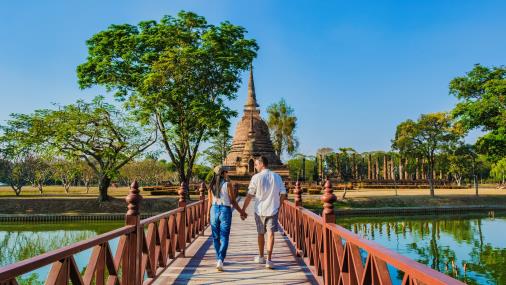Thailand, commonly referred to as the “Land of Smiles,” is a nation abundant in cultural variety and ancestral heritage. Travelers may expect a plethora of experiences, ranging from vibrant urban areas to tranquil shrines. This book will comprehensively examine all aspects of Thai culture, encompassing its customs, celebrations, historical landmarks, and gastronomic pleasures. To enhance your travel experience, contemplate utilizing an Thailand eSIM designed specifically for travelers. This eSIM service will enable you to remain connected in Thailand without the inconvenience of searching for local SIM cards, therefore enabling you to fully immerse yourself in the country’s stunning landscapes and rich cultural experiences.
Exploring Thai Temples and Sacred Sites
Thailand harbors several temples, commonly referred to as wats, each providing a distinct insight into the spiritual existence of the country. Wat Phra Kaew, situated inside the premises of the Grand Palace in Bangkok, is renowned as one of the most well-known temples. The temple has the Emerald Buddha, an esteemed figure crafted from a solitary piece of jade. This landmark is a must-visit for anybody with an interest in Thai history and culture because of its complex construction and elaborate embellishments.
Another notable temple in Bangkok is Wat Pho, where the Reclining Buddha is housed. This colossal figure is adorned with gold leaf and has a length of 46 meters. Wat Pho is renowned as the origin of traditional Thai massage, and tourists have the opportunity to indulge in a soothing massage following their exploration of the temple premises.
Located in Chiang Mai, the Wat Phra That Doi Suthep provides awe-inspiring panoramic vistas of the city from its elevated position on a mountain. The temple is a consecrated location and a well-liked destination for devotees. To reach the summit, one must ascend a stairway consisting of 306 steps, with statues of legendary serpents called nagas on either side.
Festivals and Celebrations
Thailand’s festivals are characterized by their brilliant and colorful nature, which serves as a reflection of the country’s abundant cultural variety. Songkran, the Thai New Year, is renowned as one of the most prominent festivities, occurring in the month of April. Songkran is commemorated via aquatic skirmishes, when individuals douse one another with water to cleanse themselves of ill fortune and begin the new year with a clean slate. It is a festive event that unites communities in a spirit of enjoyment and rejuvenation.
Loy Krathong, a significant event, takes place in November. During the Loy Krathong festival, individuals ceremoniously launch adorned baskets, known as krathongs, into bodies of water as a gesture of reverence towards the water deity and as a means of purifying themselves from wrongdoing. The spectacle of several illuminated krathongs drifting across the sea is undeniably enchanting. In Chiang Mai, the Loy Krathong festival aligns with the Yi Peng Lantern Festival, during which sky lanterns are launched, resulting in a magnificent display in the nocturnal atmosphere.
Traditional arts and crafts
The traditional arts and crafts of Thailand showcase the country’s abundant artistic heritage. Thai silk, known for its exceptional quality and exquisite beauty, is one of the most renowned products of the country. The silk industry in the northeastern area of Isaan is renowned. Visitors get the opportunity to investigate silk farms and observe the complex procedure of silk weaving, which encompasses the entire process from cultivating silkworms to dyeing and weaving the cloth.
One other customary art form is pottery, and the village of Dan Kwian in Nakhon Ratchasima province is renowned for its unique red clay pottery. Visitors get the opportunity to observe skilled craftsmen in action and can even attempt to create their own clay creations.
Thai dance and music are essential components of the nation’s cultural heritage. Classical dance performances, like Khon, which portray episodes from the Ramayana, are visually captivating due to their intricate attire and elegant motions. Thai music, which is performed using traditional instruments such as the khim (a sort of dulcimer) and the ranat (a wooden xylophone), adds a melodious background to these performances.
Investigating Historical Sites
Thailand’s historical landmarks provide insight into its history and the enduring influence of its ancient kings. Ayutthaya, the previous capital of the Kingdom of Siam, is a UNESCO World Heritage Site renowned for its magnificent remains. At its zenith in the 17th century, the city served as a prominent hub for trade and ranked among the world’s largest cities. Visiting Ayutthaya’s temples, palaces, and sculptures, like Wat Mahathat with its renowned Buddha head enveloped by tree roots, offers a nostalgic experience of traveling back in time.
Sukhothai, a UNESCO World Heritage Site, is commonly known as the origin of Thai civilization. The Sukhothai Historical Park houses impeccably conserved remnants of temples and palaces, showcasing the architectural style that had a profound impact on succeeding Thai art and culture. The park exhibits exceptional beauty between sunrise and sunset, as the illumination imparts a resplendent golden hue onto the time-honored edifices.
Gastronomic Legacy
Thai food is renowned globally for its vibrant tastes and high-quality ingredients. Thailand’s various regions each own unique culinary customs. Khao soi, a coconut curry noodle soup, is an essential meal to sample in the northern region. The northeastern region, also known as Isaan, is renowned for its piquant and zesty cuisine, with delicacies like as som tam (a salad made from green papaya) and larb (a spicy salad made with beef).
Bangkok provides a gastronomic expedition with its vibrant street food culture. The city’s street food sellers provide a delectable variety of foods, ranging from savory pad Thai to sweet mango sticky rice. Chinatown, also known as Yaowarat, is renowned for its street food, where sellers establish stalls along the lively streets, providing a wide range of culinary delights, including dim sum and grilled fish.
Visitors have the opportunity to enhance their culinary experience by participating in a cooking class where they may get knowledge about the intricacies of Thai cuisine. A significant number of lessons incorporate a trip to a nearby market to acquire fresh ingredients, which is then followed by practical guidance in the art of cooking traditional Thai cuisine.
Traditional Thai Medicine and Wellness
Thai traditional health and wellness practices are deeply ingrained in the cultural fabric of the country. Thai massage is a well-liked health practice that incorporates acupressure, stretching, and deep tissue massage. It has been handed down through centuries. Visitors in Chiang Mai have the opportunity to gain knowledge about traditional Thai medicine by enrolling in classes at the Thai Massage Conservation Club or the Old Medicine Hospital, both of which specialize in Thai massage.
Another method of promoting well-being is the utilization of herbal treatments, which frequently draw upon old wisdom regarding indigenous flora and their therapeutic attributes. The Museum of Thai Traditional Medicine in Bangkok offers a comprehensive exploration of the historical background and methodologies of traditional Thai medicine, encompassing the utilization of herbal remedies and therapeutic approaches.
Summary
Thailand’s cultural variety and ancient heritage provide a wide range of experiences for tourists. This gorgeous country offers a plethora of opportunities for exploration, ranging from ancient temples and historical monuments to traditional arts, crafts, and cuisine. Utilizing an eSIM for travelers can facilitate seamless connectivity during your expedition, simplifying the process of navigating and disseminating your experiences. Seize the chance to explore Thailand’s culture, and you will be enthralled by the welcoming and abundant nature of its legacy.








